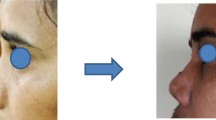Abstract
Purpose
The aim of this national survey is to assess the current practice of functional septorhinoplasty (SRP) surgery in the UK and better inform future practice.
Methods
An ENT-UK approved questionnaire was sent out to all 135 consultant members of the British Society of Facial Plastic Surgery (BSFPS). Data was collected on numbers of functional SRPs performed on the NHS, use of outcome measures, psychology and photography support, antibiotic use, referral base and consenting practice.
Results
The response rate was 38.5%, with 52 out of 135 completed. The median number of annual SRP cases per surgeon was 40. Most surgeons (95%) used clinical photography as an outcome measure. However, 27% of the respondents use a subjective outcome measurement and 3% of them use an objective outcome measurement. Only 34% had access to psychology support and 60% receive their referrals from primary care. All surgeons counsel patients for aesthetic change, 15% mention CSF leak and 38% mention olfactory disturbance. The key comment from our respondents was to relabel the rhinoplasty procedure as a functional SRP procedure with the aim to remove it from the Procedures of Limited Clinical Value (PoLCV) list.
Conclusion
The majority of our respondents perform a large proportion of the SRP surgeries in the UK with each of the respondents performing an average of 40 SRP surgeries per year. There is a need to recatergorise functional septorhinoplasty as a functional operation and recommend functional SRP surgery to be removed from the PoLCV list.
Similar content being viewed by others
References
Getting it right first time. In: https://gettingitrightfirsttime.co.uk/. Accessed 05 Sep 2019
Audit commission. Reducing spending on low clinical value treatments. In: https://webarchive.nationalarchives.gov.uk/20150423184111, http://archive.audit-commission.gov.uk/auditcommission/subwebs/publications/studies/studyPDF/3683.pdf. Accessed 21 Jul 2019
van Egmond MMHT, Rovers MM, Hannink G, Hendriks CTM, van Heerbeek N (2019) Septoplasty with/without concurrent turbinate surgery versus non-surgical management for nasal obstruction in adults with a deviated septum: a pragmatic, randomised controlled trial. Lancet 394:314–321 (Epub ahead of print)
Patel B, Virk JS, Randhawa PS, Andrews PJ (2018) The internal nasal valve: a validated grading system and operative guide. Eur Arch Otorhinolaryngol 275(11):2739–2744. https://doi.org/10.1007/s00405-018-5142-x
Poirrier A, Ahluwalia S, Kwame I, Hannan S, Bentley M, Andrews P (2014) External nasal valve collapse: surgical techniques and outcome measurement. Rhinology 52(2):127–132
Andrews PJ, Choudhury N, Takhar A, Poirrier AL, Jacques T, Randhawa PS (2015) The need for an objective measure in septorhinoplasty surgery: are we any closer to finding an answer? Clin Otolaryngol 40(6):698–703
Gerecci D, Casanueva FJ, Mace JC, Annen A, Barrett DM, Kim MM, Wang TD, Smith TL, Loyo M (2019) Nasal obstruction symptom evaluation (NOSE) score outcomes after septorhinoplasty. Laryngoscope 129(4):841–846
Takhar A, Stephens J, Randhawa P, Poirrier AL, Andrews P (2014) Rethinking sino-nasal outcome: validation of the sino-nasal outcome test-23 in septorhinoplasty. Rhinology 52(4):320–326
Menger DJ, Richard W, Smart KM, Grolman W (2015) Does functional septorhinoplasty provide improvement of the nasal passage in validated patient-reported outcome measures? ORL J Otorhinolaryngol Relat Spec 77(3):123–131
Ansari E, Rogister F, Lefebvre P, Tombu S, Poirrier AL (2019) Responsiveness of acoustic rhinometry to septorhinoplasty by comparison with rhinomanometry and subjective instruments. Clin Otolaryngol. https://doi.org/10.1111/coa.13394(Epub)
Rhee JS, Sullivan CD, Frank DO, Kimbell JS, Garcia GJ (2014) A systematic review of patient-reported nasal obstruction scores: defining normative and symptomatic ranges in surgical patients. JAMA Facial Plast Surg 16(3):219–225
Fuller JC, Levesque PA, Lindsay RW (2017) Assessment of the EuroQol 5-dimension questionnaire for detection of clinically significant global health-related quality-of-life improvement following functional septorhinoplasty. JAMA Facial Plast Surg 19(2):95–100
Bulut OC, Wallner F, Oladokun D, Kayser C, Plath M, Schulz E, Plinkert PK, Baumann I (2018) Long-term quality of life changes after primary septorhinoplasty. Qual Life Res 27(4):987–991
Poirrier AL, Ahluwalia S, Goodson A, Ellis M, Bentley M, Andrews P (2013) Is the sino-nasal outcome test-22 a suitable evaluation for septorhinoplasty? Laryngoscope 123(1):76–81
Ross EE, Anari S (2018) Clinical commissioning group criteria for rhinoplasty and septorhinoplasty in England: survey of current guidance. J Laryngol Otol 132(7):591–595
IMI National Guidelines. A guide to good practice: rhinoplasty and septorhinoplasty (2019). In: https://www.imi.org.uk/wpcontent/uploads/2019/03/2019_Mar_IMINatGuidelines_Rhinoplasty_V2x-1.pdf. Accessed 21 Jul 2019
Andrews P, Joseph J, Li CH, Nip L, Jacques T, Leung T (2017) A UK survey of current ENT practice in the assessment of nasal patency. J Laryngol Otol 131(8):702–706
Murrell G (2013) Components of the nasal examination. Aesthet Surg J 33:38–42
Joseph J, Randhawa P, Hannan SA, Long J, Goh S, O’Shea N, Saleh H, Hansen E, Veale D, Andrews P (2017) Body dysmorphic disorder in patients undergoing septorhinoplasty surgery: should we be performing routine screening? Clin Otolaryngol 42(3):508–513
Randhawa PS, Watson N, Lechner M, Ritchie L, Choudhury N, Andrews PJ (2016) The outcome of septorhinoplasty surgery on olfactory function. Clin Otolaryngol 41(1):15–20
Youssef A, Ahmed S, Ibrahim AA, Daniel M, Abdelfattah HM, Morsi H (2018) Traumatic cerebrospinal fluid leakage following septorhinoplasty. Arch Plast Surg 45(4):379–383
Reid E (2015) Montogomery v lanarkshire health board and the rights of the reasonable patient. Edinburgh Law Rev 19(3):360–366
Rohrich RJ (2001) Mirror, mirror on the wall: when the postoperative reflection does not meet patients’ expectations. Plast Reconstr Surg 108:507–509
Cunningham CT, Quan H, Hemmelgarn B, Noseworthy T, Beck CA, Dixon E et al (2015) Exploring physician specialist response rates to web-based surveys. BMC Med Res Methodol 9:15–32
Author information
Authors and Affiliations
Corresponding author
Ethics declarations
Conflict of interest
The authors declare that we have no conflict of interests.
Human and animal rights statement
This article does not contain any studies with animals performed by any of the authors.
Informed consent
There was no patient identifiable information in our study.
Additional information
Publisher's Note
Springer Nature remains neutral with regard to jurisdictional claims in published maps and institutional affiliations.
Rights and permissions
About this article
Cite this article
Unadkat, S., Pendolino, A.L., Joshi, A. et al. A national survey of functional septorhinoplasty surgery performed in the United Kingdom: a clinician end-user questionnaire to assess current practice and help inform future practice. Eur Arch Otorhinolaryngol 277, 475–482 (2020). https://doi.org/10.1007/s00405-019-05722-z
Received:
Accepted:
Published:
Issue Date:
DOI: https://doi.org/10.1007/s00405-019-05722-z




